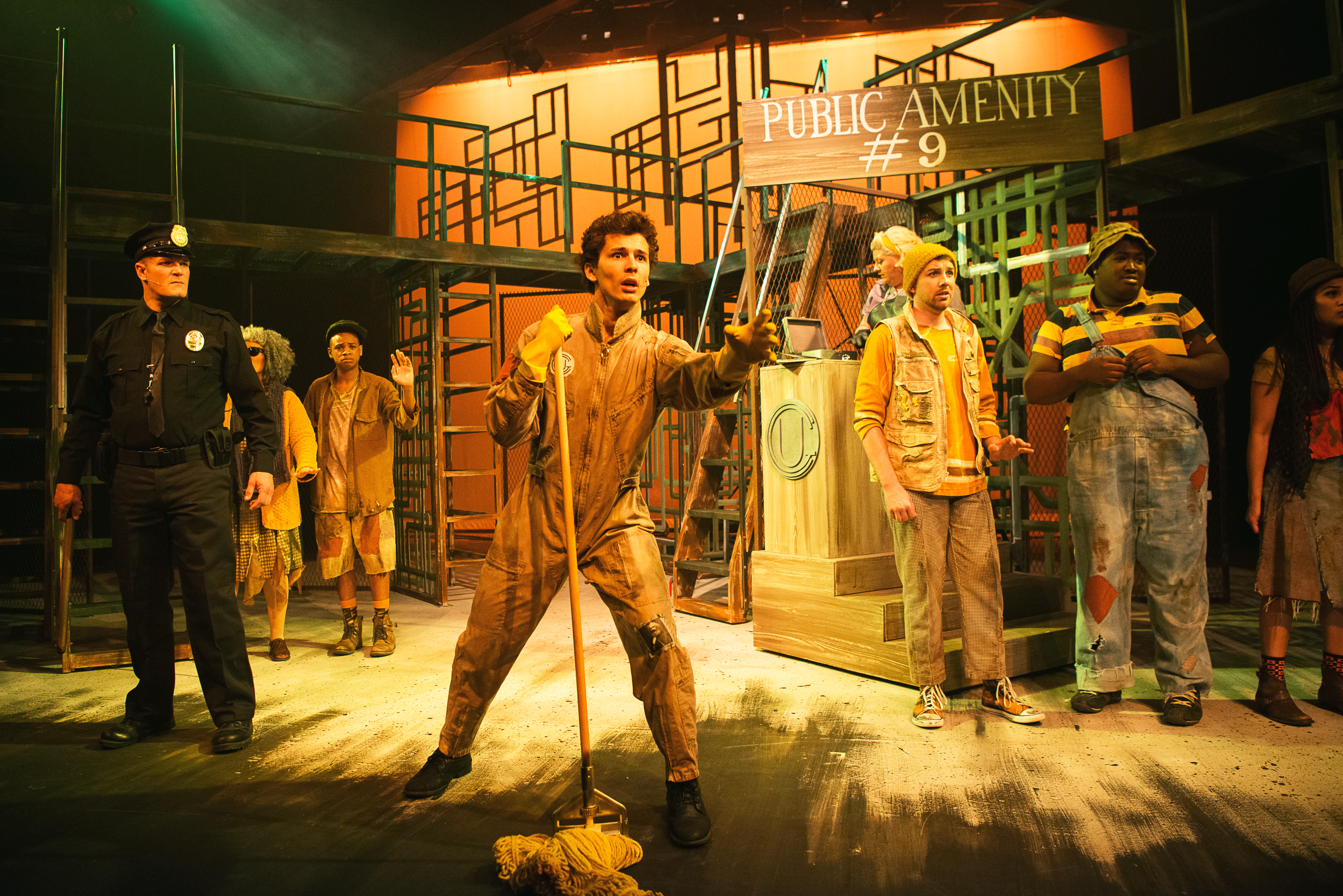 |
| Berkeley Playhouse photo |
The Play
I guess you would have to call this a dark, satirical musical. The songs are pretty upbeat, but the material is pretty grim. Set in a place suffering ongoing drought, leading to a water shortage, so private toilets are outlawed, forcing everyone to urinate (for a fee) at public toilets. But those amenities are all controlled by a gigantic corporation (Urine Good Company). Anyone who violates the laws requiring urination for a fee is sent to "Urinetown" as punishment. The nature of Urinetown is one of the topics of discussion in the show.So the key characters in the show are the CEO of the company, Caldwell B. Cladwell (played by Paul Plain), the policemen who enforce the strict laws, Officers Lockstock and Barrel (Matt Davis and Zac Schuman, respectively), Little Sally (Brittney Monroe) who draws exposition from Lockstock, and the hot-headed idealist, Bobby Strong (Nikita Burshteyn). Also important are Miss Pennywise (Jessica Coker), who runs Public Amenity #9, and Hope Cladwell (Andrea J. Love), Caldwell's daughter and the love interest for Bobby.
Ultimately the play is a commentary on privatization, capitalist greed, class politics, law enforcement, and sustainability. There are plenty of fun songs, great puns, pokes at other Broadway shows (and musicals as a genre), and a general breaking of the fourth wall.
The Production
I thought the show was quite well done. Several of the performers really stood out for me. Jessica Coker's "Pennywise" can really belt out the songs. Matt Davis as "Officer Lockstock" (who narrates much of the show) managed to both sing the difficult songs and maintain a sort of snarky self-awareness that made it fun to watch. Monroe as "Little Sally" manages to be convincing as the precocious street urchin who is both foil and partner to Lockstock at times. And Nikita Burshteyn really holds his own in the lead role as Bobby Strong.The set itself was fairly simple (and others in my party recognized parts of it as being reused from the recent production of Billy Elliot) but effective, lighted well and flexible enough to do quick scene changes. The cast as a whole danced quite well, and I thought the choreography was pretty ambitious for a local theater company. Most of the voices were good, although there were some issues with the audio system at the show we attended (but not enough to do serious harm to the play). And the orchestra was good, if a bit loud at times.
Overall, I thought the cast did a good job of maintaining the flow of the show. Being a bit quirky, it can be tough to keep it going and still maintain the storyline, but they did that well. Director Danny Cozart deserves credit for making the pace work for his cast.
Bottom Line
This is a really fun production, of high quality and good amusement value. My family members who had not seen or read the show previously were especially amused, and those of us who had seen it before enjoyed remembering how much fun it was. The clash between the privileged wealthy and the downtrodden poor is still all too timely, and the theme of resource shortages and sustainability running afoul of corporate interests is particularly pertinent today.Frankly, I had been expecting one of the local theaters to revive this show during the last years of the recent California drought, and was surprised that only a few smaller, local houses took it on. It seems like this is both a high-quality show (it won Tony Awards for both best book and best score), but a fun and timely one, too.
It runs for one more weekend, so you should definitely go check it out. As Mr. Cladwell tells Hope, "Don't be the bunny!" (Go see the show: you'll get it.)
